Like all flowers and fruit trees, Pomegranate needs high nitrogen and enjoys acidic soil. Nitrogen helps plants grow and can improve fruit intake and quality. A balanced fertilizer containing nitrogen will provide your Pomegranate tree with everything it needs to succeed. Unless you have a lot of sandy soil that doesn’t keep the nutrients well, Pomegranate plants need very little fertilizer. Let’s check out the best fertilizer for pomegranate tree.
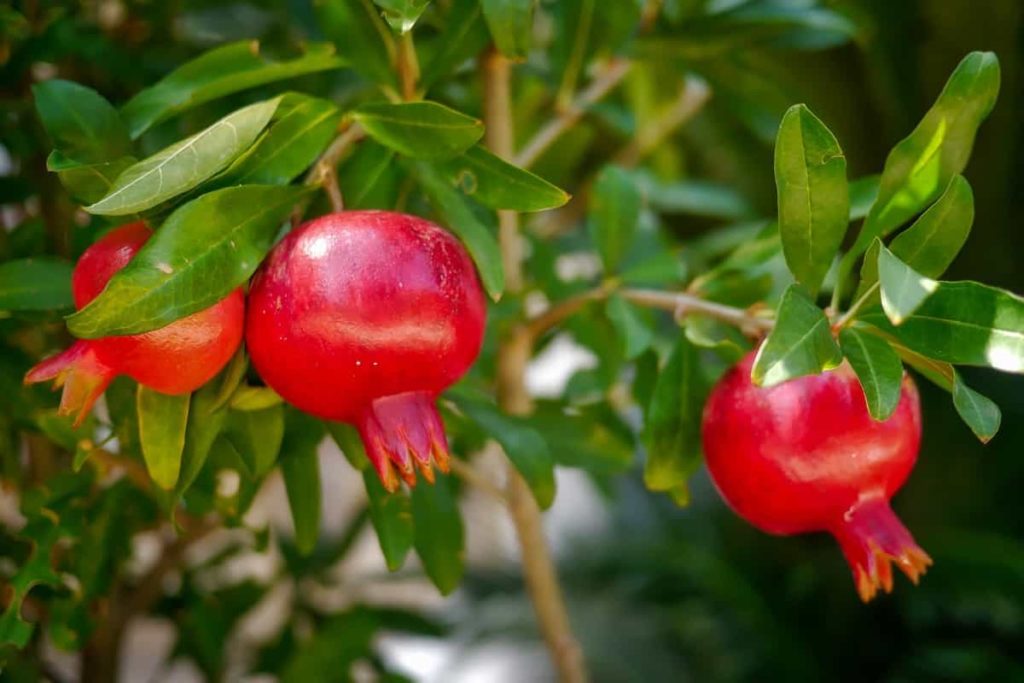
The only factor Pomegranate trees need is nitrogen, and how much is applied will depend on the age of the plant. Do not compost your Pomegranate at all during the first year. Pomegranate trees starting in the second year can be fed with organic plant food or non-organic fertilizers such as slow-release bush and tree-type fertilizer. Alternatively, Pomegranates can be fed through mulching with organic fertilizer.
Keep in mind that too much fertilizer is bad, so it is better to apply as little as possible. Too much fertilizer will cause heavy growth of leaves, which can affect fruit production and even cause the fruit to fall prematurely. Applying too much fertilizer or applying it at the end of the year from recommended can make the fruits mature late, and have a bad complexion and poor taste. Fertilizer should be given at a distance of 1 meter from the tree.
Natural and organic fertilizers for Pomegranate tree
- If you choose to make your own, add plenty of scraps from leafy greens and any coffee ground you have. Add coffee ground directly to the soil in your garden. You can scratch it in the top two inches of soil, or just sprinkle the field above and leave it alone. In small quantities, especially when combined with dry material, coffee grounds will leave their nitrogen.
- Get sweet fruits after applying Epsom salt. Epsom salts can be applied to Pomegranate fruit trees either directly on soil in dry form or as a foliar spray. Mixing 1/2 cup of Epsom salt with water for every 500 ft of soil you need to cover.
- Neem cake is used as organic fertilizer due to several micro and macronutrients on which it is made. It will control soil-based germs as well as nematodes. You can apply one kilo of neem cake per plant. Castor cake is natural nitrogen fertilizer. It is a simple fertilizer, which works gradually and encourages soil microbial activity. Apply 500 grams of castor cake per plant.
In case you miss this: Pomegranate Growing Tips, Ideas, Techniques, Secrets
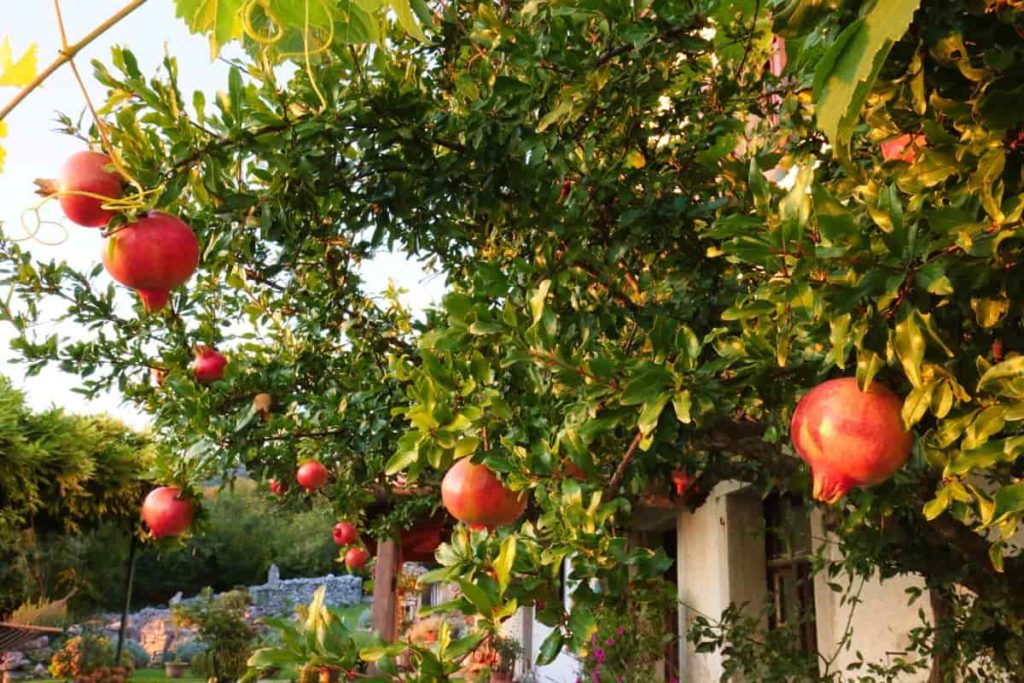
Compost manure for the Pomegranate tree
Compost
Prepare the compost pile by layering it with high nitrogen ingredients like grass clippings, kitchen scraps, and coffee grounds such as fertilizer, alpha, and peas or bean cuttings. Add brown ingredients such as chopped newspapers and layers of sawdust. The general proportion of your compost pile should be 25% more nitrogen, 45% green, and 30% brown ingredients.
Sprinkle each of the water after adding it to the compost pile. When the compost pile is complete, let it sit for 3 days, then measure its inner temperature with a long temperature gauge. Continue checking the temperature daily. Prepare the manure to brew when it reaches the dark brown, crumbly stage in four to eight weeks.
In case you miss this: Growing Pomegranate In The Backyard
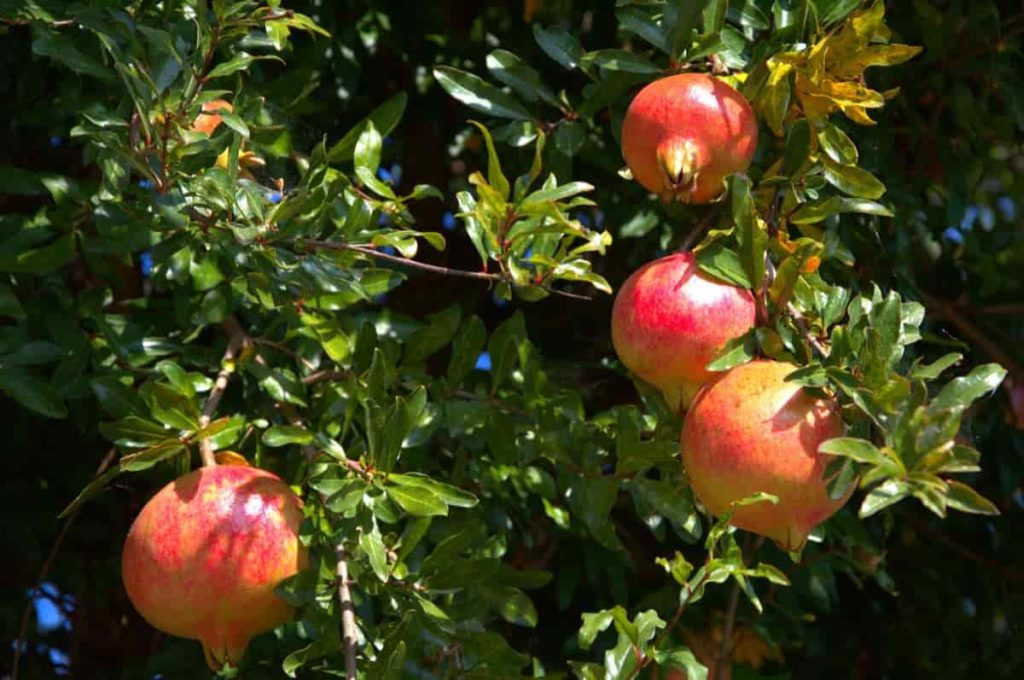
Typically, the temperature of the compost pile will drop from 37 to 43°C and remain at the same level, indicating that the composting process has been completed. Before composting, the trees should be allowed to be established in their environment. Teenage trees between the ages of 3 and 5 need 1 to 1.5 kg of compost in November and then in March. Old trees need 2 to 2.3 kg of compost applied at the same time.
Farmyard manure
Farmyard manure is mainly prepared using cow dung, cow urine, waste straw, and other dairy waste. You can apply 5 to 6 kg farmyard manure on a two-year-old Pomegranate plant.
Vermicompost
Vermicompost is an organic fertilizer rich in nutrients, easily defective in biodegradable carbon, and relatively independent of any plant and human germ. Apply 2 kg vermicompost per plant.
Homemade fertilizers for the Pomegranate tree
- Attach the aquarium pump to two or three air stones. Place the air stones in a bucket of 5 gallons. Fill the bucket with water. Plugin the pump and let the air stones bubble for several hours or overnight to remove chlorine in the water. Remove the air stones from the water. Place the air stones in an empty 5-gallon bucket. Cover the air stones with well-rotten manure, fill the bucket half full.
- Add bubbly water to the compost, fill the bucket within 3 to 4 inches of the rim. Turn on the pump. Put, a cup of bubble water in a jar. Add one and a half tablespoons of molasses and a packet of yeast to the jar. Screw the lid on the jar and stir well to mix the ingredients, then pour the mixture into a 5-gallon bucket with the fertilizer. Stir the manure tea two or three times a day while it is consumed. Compost tea after three days is ready to be applied to your Pomegranate tree.
In case you miss this: Pomegranate Seed Germination, Time, Process (Anar)

- Pour compost tea into the garden’s prayer. Apply tea as a foliar spray every two to four weeks during the increasing season. Apply compost tea as two weekly liquid fertilizers after watering the tree thoroughly. Avoid any fertilizer use after August, as fertilizer tender encourages new growth that can withstand damage as winter approaches and the weather cools.
- Peat moss can be added as a two to three-inch-thick top dressing and raked in the soil in the spring, to acidify the alkaline soil. Well-aged manure or chopped leaf mulch added to the soil in late winter are the best sources of available organic material that can also boost your tree or shrub before the onset of the growing season.
Commercial fertilizers for the Pomegranate tree
- Pomegranate can also be grown in low fertile soil. Nevertheless, recommended food for chemical fertilizers should be added to the pit for better production and quality of fruits. Compost and fertilizer food varies from region to region.
- During the first year after planting, the Pomegranate tree is growing and establishing itself. In the meantime, it does not need any additional fertilizer except mulch or compost. During this year of rapid growth, your plant needs to change rapidly and it is easy to increase any given nutrients too much, which can stop growth.
- During the second year, you are free to add a small amount of fertilizer. 30 to 60 grams of fertilizers included in spring and fall is enough. Each year after another, the number of fertilizers increases by another 30 grams which last for five years.
- No fertilizer is necessary for many trees. While adding things to the soil can be tempting that could potentially benefit your plants, it can burden the soil. It is important to consider whether your plants need to grow. If your trees look sick, not growing as expected, or if soil testing shows that you are deficient in the soil.
In case you miss this: Growing a Pomegranate Plant, Propagation, Care
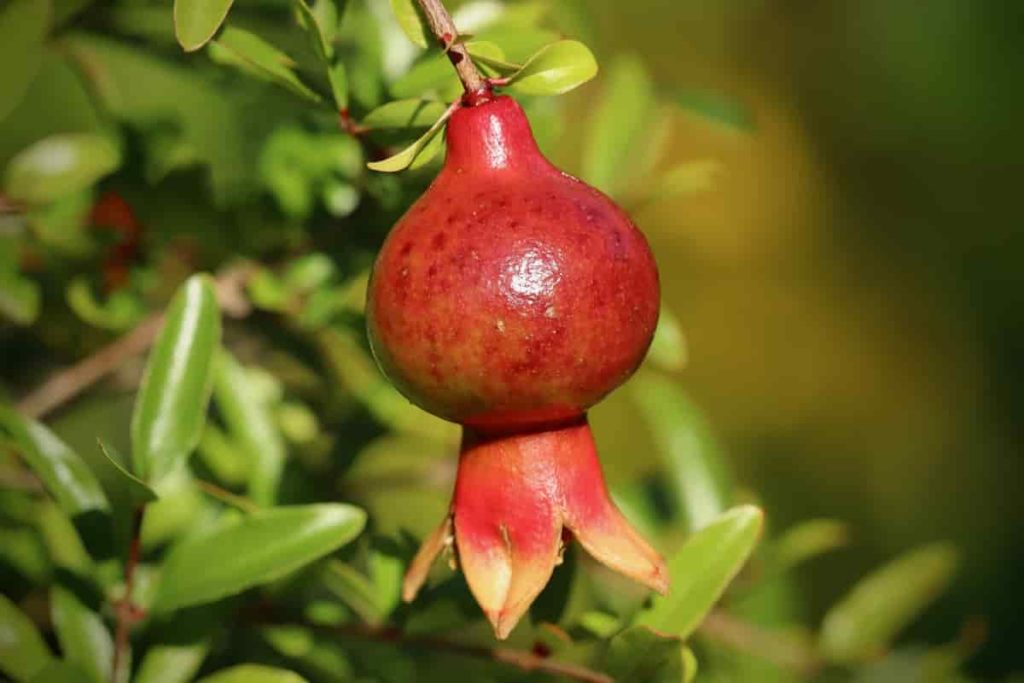
NPK ratio – The Pomegranate tree needs proper nitrogen for the best growth, as nitrogen supports leaf growth and flower production that eventually establishes fruit. For Pomegranate trees, manure with a nutritional ratio of 8-8-8 NPK (nitrogen, phosphorus, and potassium) is sufficient. You can use ammonium sulfate, a high nitrogen fertilizer, or a balanced 10-10-10 formula, starting to show new tree growth after it starts in spring.
Fertilizer’s schedule
- For a newly planted young tree, apply 30 grams of 10-10-10 manure per 1 ft of plant height. For example, if your Pomegranate plant is 3 feet long, apply 90 grams 10-10-10. You can fertilize three applications at this rate, one each in early spring, late spring, and early fall. Scratch the manure in the soil within a radius of 1 inch in diameter, the Pomegranate bush is located in the middle of this circle. Mature Pomegranates use 200 to 400 grams of nitrogen every year. Pomegranate in normal soil requires about 1 kg of 8-8-8 fertilizer in March. Pomegranates can also recover this amount of fertilizer in November.
In case you miss this: Top 15 Fruits to Grow in Pots
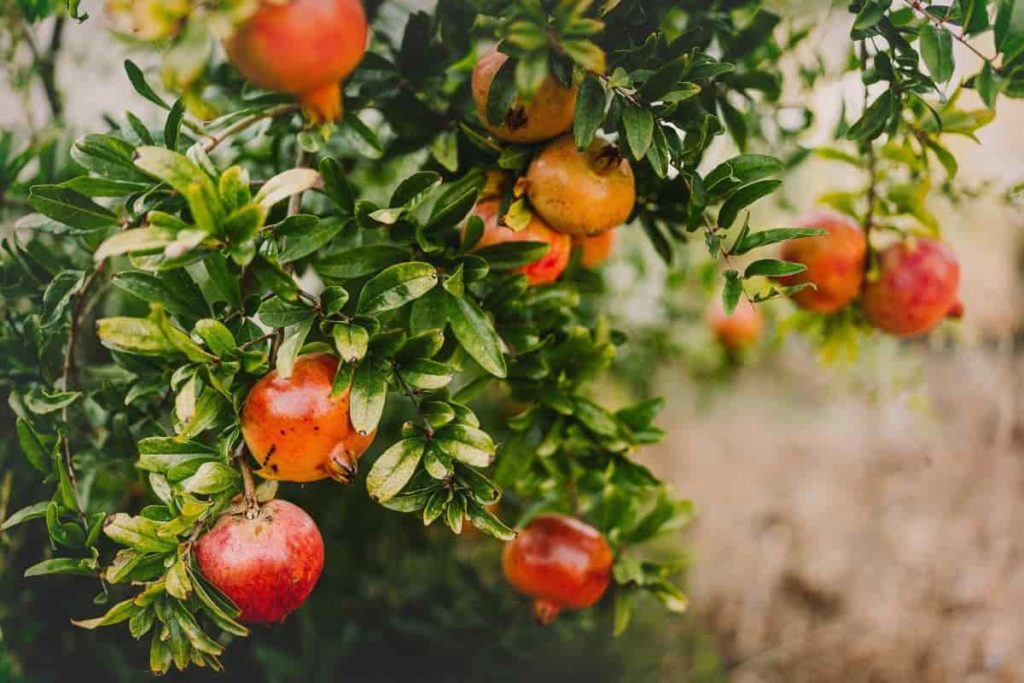
- As the Pomegranate tree grows, it needs more fertilizer in proportion every year until it reaches a maximum of 230 grams on each of the three request times. Increase the diameter of the circular application area, and avoid digging too deep when applying fertilizer, so the roots don’t bother. In the absence of rain, it is a good idea to water the tree well after each application to help nutrients reach the roots of the tree.
- Put Urea 50 grams into two equal divisions each year. The first dose is given in March and the second dose is given in April. After 5 years, start adding urea 250 grams per plant.
How to fertilize Pomegranate in pots
The Pomegranate tree is regularly composted during the increasing season. Fertilize every two to three weeks using liquid 8-8-8 fertilizer as per the manufacturer’s instructions. The Pomegranate tree in the pots often becomes deficient in zinc, which is identified by yellow leaves. To control this, you can spray a thin zinc solution on leaves. The application of compost or fertilizer is also beneficial.
Be careful not to fertilize it more than nitrogen-rich manure as it can produce a lot of leaves and relatively few flowers. Fertilize the tree with 118 ml of 10-10-10. Spread the manure over the soil and 5 centimeters away from the stem. Water the food in the soil. Feed-in November, February, and May during the first two years of tree development followed only by fertilizers in November and February.
Frequently asked questions about best fertilizer for pomegranate tree (FAQ)
Can I use citrus fertilizers on Pomegranate?
If you choose not to test your soil, and your Pomegranate tree is healthy and thriving, would be not to use citrus fertilizer.
How do you increase the size of fruits in Pomegranate?
0.25% of the foliar application of each zinc sulfate, manganese sulfate, and iron sulfate combined with 0.15% boric acid, you can observe a significant increase in fruit production and quantity of Pomegranate fruit juice.
Why is my Pomegranate flower no more?
Inadequate levels of light are a central reason why Pomegranate plants fail to produce any flowers. Garden exposure that provides at least 8 to 10 hours of direct sun rays per day, is a necessity, especially from spring to fall. The more sun and warmer the temperature of the rising weather, the better.
- How to Grow Tomatoes Organically at Home: A Comprehensive Guide
- Organic Gardening on a Budget: Low-Cost Methods and Materials
- Gongura Seed Germination and Planting Methods
- Cabbage Seed Germination and Selection
- Broccoli Seed Germination and Selection
- Asparagus Seed Germination and Variety Selection
- Seasonal Flower Gardening: Best Practices for Spring, Summer, Fall, and Winter
- How to Grow Hibiscus from Flower
- Plantation Ideas for Home Decoration: A Beginners Guide
- Flower Garden Designs and Layouts for Beginners
- Planting and Spacing Techniques in Papaya: A Beginner’s Guide
- Growing Gold: Essential Techniques for Planting Pineapples
- How to Make Kalanchoe Plant Bushy: Home Remedies and Solutions
- 11 Reasons Why Your Gardenia is Not Blooming: Home Remedies and Solutions
- Eco Elegance: The Guide to Designing a Drought-Tolerant Landscape
- Gardening on a Slope: Strategies for Hillside Landscaping
- Nourish and Flourish: Top Organic Mulches for Thriving House Plants
- Everything You Want to Know about Indian Mogra Flower: Discover Uses and Growing
- Green Thumb Success: Expert Tips for Cultivating Greenhouse Pumpkins All Year Round
- Maximize Growth & Flavor: The Ultimate Guide to Companion Planting in Herb Gardens
- How to Control Rhododendron Problems Naturally: Home Remedies and Organic Ways to Fix Them
- Natural Magic: The Remarkable Benefits of Cinnamon for Plants
- Best Steps to Revive Dying Tulip with Natural and Organic Treatment
- 10 Reasons Why Your Angel Trumpet is Not Blooming: Remedies and Treatment
- How to Fix Periwinkle Leaf and Flower-Related Problems: Natural Remedies and Solutions
- How to Fix Zinnias Leaf and Flower Problems: Discover Natural and Home Remedies
- Organic Steps to Induce Lemon Tree Flowers: A Comprehensive Guide
- Bloom Booster: Crafting the Perfect Homemade Bougainvillea Fertilizer
- Optimizing Growth: A Guide to Applying NPK Fertilizer for Potted Plants
- 10 Best Homemade Fertilizers for Rubber Plant: DIY Recipes and Application Method
- How to Boost Female Pumpkin Flowers: Effective Steps for More Flowers and High Yields
- Transform Your Indoor Garden: Top Benefits of Pink Salt for Houseplants
- 10 Best Homemade Fertilizers for Peacock Plants (Calathea): Easy DIY Guide
- Unlock Blooms: 9 Reasons Why Your Potted Chrysanthemum is Not Blooming
- 8 Reasons Why Your Potted Hibiscus is Not Blooming: Fix it with Simple Solutions
- Unlock Blooms: 9 Key Reasons Your Potted Frangipani Won’t Flower